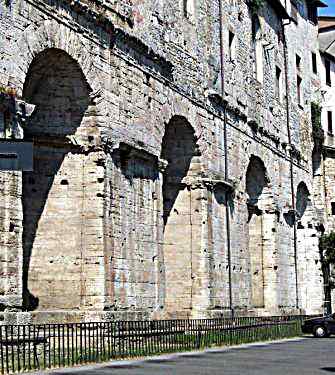Todi's country
The City Walls and the “Nicchioni”
The summit of the hill upon which Todi
stands has always been faced with problems related to the
geological nature of the subsoil. Frequent landslides and
the resulting periodic destruction of buildings has
forced the people to seek various means to counteract
this phenomenon. Since Roman times the main cause of the
landslides has been known to be that of the layers of
soil absorbing excessive water: therefore it was
essential to build a complex network of drainage channels
to carry away the excess water, and at the same time to
reinforce the slopes of the hill with substructures to
prevent collapses. Many of these substructures are
visible on the sides of the hill, and are often quite
massive, such as the large bastion over the Fosso delle
Lucrezie, on the northern slope, or that which forms the
base of the San Fortunato monastery, toward the south.
One of the most well-known structures is the one built on
the southern slope of the hill, providing support for the
summit area; given that it is in a particularly important
spot and is visible from the roads passing through the
valley below, creating a kind of scenic backdrop to a
large open area, this bastion was built with a series of
large niches (“nicchioni”). In the past it was
believed to be the remains of temple dedicated to Mars, a
god highly venerated in Todi. Recent research, however,
has revealed instead that it is a foundation structure
over nine meters deep, in opus caementicium, which above
ground was covered with slabs and blocks of travertine.
The coping above the niche vaults consisted of a fascia
with metopes and triglyphs, above which was the parapet
of a second large square at a higher level. Inside was a
cistern for collecting water, along with a drainage
conduit. A floor mosaic with marine motifs in white and
black tesserae was found in one of the niches; it
probably decorated the basin of a nymph set against a
monument.

La cinta muraria ed i Nicchioni
La parte sommatale del colle su cui sorge la città di Todi ha da sempre dovuto affrontare problemi legati alla natura geologica del sottosuolo; le frequenti frane e la conseguente periodica distruzione dei manufatti ha costretto le popolazioni a ricorrere a mezzi di vario tipo per contrastare il fenomeno; fino da epoca romana fu individuata la principale causa dei dissesti, nell’eccessiva imbibizione degli strati di terreno su cui sorgeva il centro: fu pertanto indispensabile realizzare una complessa rete di cunicoli drenanti ai quali affidare l’eliminazione dell’acqua in eccesso, e al contempo rinforzare le pendici con sostruzioni anche imponenti che ne impedissero il collasso. Lungo i fianchi del colle sono visibili molte di tali costruzioni, anche di dimensioni imponenti, come il grande bastione sovrastante il fosso delle Lucrezie, sul versante settentrionale, o quello che forma la base del complesso monastico di San Fortunato, verso sud. Una delle strutture più note è quella costruita sul versante meridionale del colle, a sostegno della zona sommitale; essendo posta in una zona particolarmente importante e visibile dalle vie di comunicazione che scorrevano nella vallata sottostante, e formando una sorta di quinta scenografica ad un grande piazzale, il bastione fu sistemato con una serie di nicchie, che in antico lo fecero ritenere come resto di un tempio dedicato a Marte, divinità ampiamente venerata nella città. Le recenti ricerche hanno permesso di identificare una struttura fondale profonda oltre nove metri, in opera cementizia, che sopra terra era stata rivestita da lastre e blocchi di travertino; il coronamento superiore, al di sopra della volta delle nicchie, era formato da una fascia a metope e triglifi, sopra la quale era il parapetto di una seconda grande piazza ad un livello superiore. All’interno, oltre ad un cunicolo drenante, era stata scavata una cisterna per la raccolta delle acque. In una delle nicchie è stato scoperto un mosaico pavimentale con motivi marini a tessere bianche e nere, che probabilmente decorava la vasca di un ninfeo addossato al monumento.